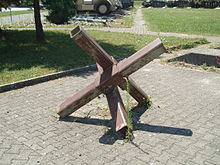Czech hedgehog

A Czech hedgehog , known as an armored hedgehog in Austria and a steel spider in Switzerland , is a barrier that was primarily used as an anti-tank barrier in the 20th century . He can be seen as a further development of the Spanish rider .
Czech hedgehogs usually consist of three 1.5–2 meter long profile steel girders that are cross -welded crookedly together. But there were also riveted designs or those made of concrete . In some versions, only two beams were welded together and the third was only screwed on to facilitate transport. Practically any material that is currently available can be used, for example disused railroad tracks . Therefore, Czech hedgehogs are also well suited for improvised on-site production.
This form of anti-tank barrier was used extensively by Czechoslovakia in the construction of the Czechoslovak Wall in the 1930s . After the occupation of the country ( Sudeten crisis in autumn 1938 and destruction of the rest of the Czech Republic in March 1939) the German Wehrmacht used the captured Czech hedgehogs for their own fortifications and had new ones made on a large scale. For example, Omaha Beach was secured with Czech hedgehogs, among other things. Czech hedgehogs were later also used by other countries, such as the Eastern Bloc countries on the iron curtain . The GDR used them on the inner-German border and on the Berlin Wall .
literature
- Harry Lippmann: Tank traps and other obstacles. German Atlantic Wall Archive, 3rd edition (1997),
See also
- Crow's foot - smaller, tetrahedral construction with a similar purpose
- Hump line (concrete anti- tank barrier)

